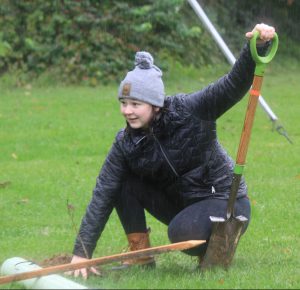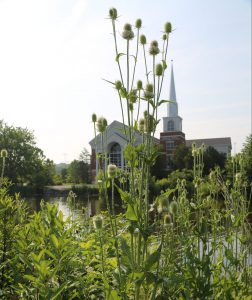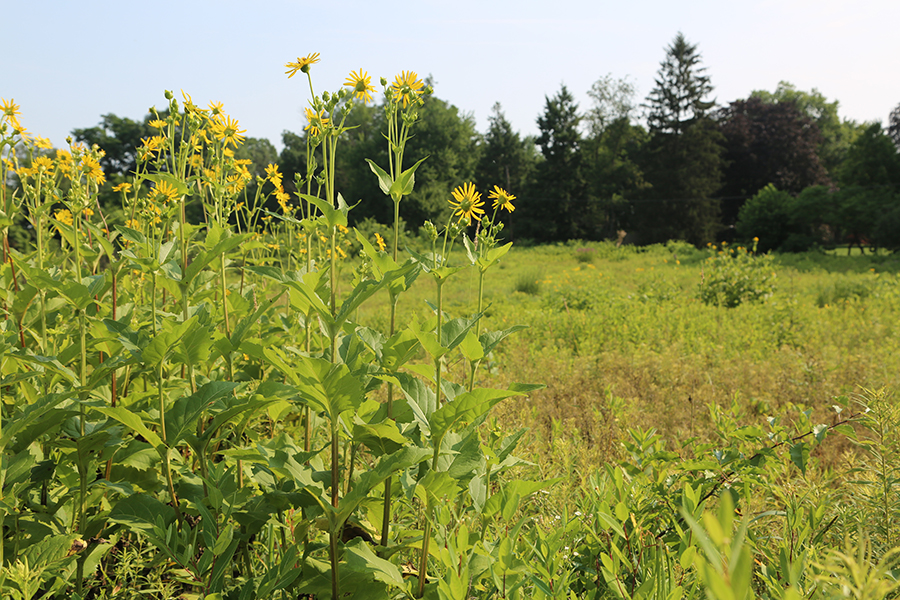Elizabethtown College is partnering with the Alliance for the Chesapeake Bay to participate in a lawn conversion program that will help the Commonwealth of Pennsylvania meet its Chesapeake Bay pollution reduction goals.
The project is the latest sustainability initiative for the College, which for many years has taken a proactive approach toward reducing its impact on the environment. 
The lawn conversion began taking place this fall on both sides of the Brown Building parking lot, which is located across College Avenue from Lake Placida. The 0.63 acres of lawn on the left side of the lot is being converted to forest and will feature nearly 25 species of native trees and shrubs such as sweetbay magnolia, American plum, black cherry, and spicebush. Trees are being planted in a 10’x15’ spacing pattern with a total of 175 trees going into the ground.
A lawn to meadow conversion is planned for 1.1 acres of land on the right side of the Brown lot. Native wildflowers will eventually be planted in stages, adding significant square footage to an existing pollinator meadow. Throughout its existence, the current meadow has been used by Etown students for course-based research. This project will help to further expand on those volunteer and educational opportunities for students.
“It is so important for college students to get involved with sustainability work,” said Ryan Davis, Pennsylvania Forests Projects manager at Alliance. “There is a massive amount of work to do and we simply don’t have enough people to get the jobs done.
“It’s also extremely beneficial for students to see how concepts like reforestation actually work in the real world, not just as an academic exercise.”
This partnership has already led to an internship opportunity for environmental science major Katie Hollen ‘22, who worked with Alliance over the summer. Hollen assisted with the upkeep of riparian forest buffer zones and other lawn conversion sites, as well as taking part in conversations with farmers and other landowners of existing or potential sites.
“My internship with Alliance helped me develop hands-on, physical skills that will be helpful for a career in the environmental science field,” said Hollen. “This was an incredible opportunity to do a broad range of work with both plants and people, and to learn how to apply classroom knowledge to real-world situations.”
Lawn conversion in the area is critical for reducing sediment and nutrient impacts on the Chesapeake Bay. Densely planting trees and replacing lawn cover with native wildflowers and grasses helps to slow stormwater flow and infiltration in the Chesapeake Bay watershed.
A grant was attained by Alliance through the Pennsylvania Department of Conservation and Natural Resources (DCNR) and the National Fish and Wildlife Foundation in early 2020 with the goal of converting 1% of Pennsylvania’s lawn cover in the watershed, which comes out to a staggering 10,000 acres.
Alliance was seeking candidate institutions for the project and Etown’s available land on either side of the Brown lot made the College a natural fit. The space is considered extra valuable for the lawn conversion since a small stream running alongside the area has the potential to improve the water quality and health of the Chesapeake Bay.
“Initiatives like this can provide ways for students to make a positive difference in ways that relate to the education they are pursuing,” said Diane Bridge, Associate Professor of Biology. “Associations with external organizations can open opportunities for student internships. They can give students a chance to learn about career options related to sustainability, which is likely to be an area of growth in the coming decades.”
The planting and preservation of native trees on campus have long played a crucial role in the College’s sustainability goals. A seven-acre wildlife meadow at the southern end of campus also helps prevent water runoff and is home to deer, turtles, turkey, and birds.
Several native plant meadows dot the Etown landscape, providing for pollinators and featuring native flowers such as blooming milkweed. Behind the Dell gazebo, you can come across a grove of fruit-bearing Pawpaw trees which help support the zebra swallowtail butterfly.
 Pawpaw trees generate small fruit that ripens in early October. The fruit has the appearance of a mango and tastes like a cross between a mango and a banana. SEEDs collaborated with the Student Wellness Advocacy Group in October to host a Pawpaw smoothie tasting event in the Bowers Center Demo Kitchen.
Pawpaw trees generate small fruit that ripens in early October. The fruit has the appearance of a mango and tastes like a cross between a mango and a banana. SEEDs collaborated with the Student Wellness Advocacy Group in October to host a Pawpaw smoothie tasting event in the Bowers Center Demo Kitchen.
SEEDs continues to take full advantage of the wealth of opportunities these native plants provide on the Etown campus, including the harvesting of native pollinator plant seeds last fall. In the spring, the SEEDs club sponsored a Day of Service activity in which campus community members planted those seeds and were eventually donated to the Lancaster Conservancy during the summer to provide for pollinator planting projects.
The College’s long-standing focus on sustainability has positioned Etown as a regional leader in the space. In November, the College is hosting the Lancaster-Lebanon Watershed Forum and Science Symposium, where local partners who are conducting research, advancing science, and working to improve the area’s watersheds are invited to gather and share their work across the two-day event.
Etown’s campus was recently assessed by the Lancaster Conservancy Community Wildlife Habitat initiative and was granted designation by the National Wildlife Federation as certified wildlife habitat.

